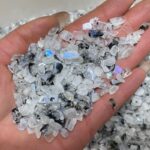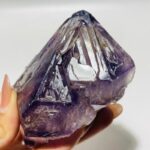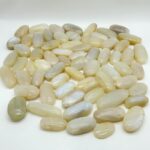Introduction

Rock crystal, a colorless and transparent variety of quartz, has captivated humans for centuries with its remarkable properties and aesthetic allure. Its value extends beyond mere monetary worth, encompassing scientific, historical, and spiritual significance. This in-depth guide delves into the multifaceted aspects of rock crystal, exploring its characteristics, uses, and financial implications.
Physical Properties
Rock crystal is a member of the quartz family, with a chemical composition of silicon dioxide (SiO2). It exhibits a Mohs hardness of 7, making it relatively resistant to scratching. Its transparent and colorless nature allows light to pass through it with minimal distortion, resulting in its characteristic sparkle and brilliance.
- Crystal habit: Rock crystal typically forms hexagonal prisms with pointed terminations.
- Density: 2.65 g/cm³
- Refractive index: 1.544-1.553
- Solubility: Insoluble in water
Geological Formation
Rock crystal is primarily found in hydrothermal veins and pegmatites, geological formations created by the crystallization of hot, mineral-rich fluids. These fluids deposit quartz crystals along the walls of fissures and cavities in rocks. The conditions under which these fluids cool and crystallize determine the size, shape, and clarity of the rock crystals.
Uses
The versatility of rock crystal has made it a valuable resource in various fields:
1. Optics: Rock crystal is essential for the production of high-quality lenses, prisms, and other optical components. Its high transparency, low birefringence, and durability make it ideal for use in applications such as camera lenses, telescopes, and medical instruments.
2. Jewelry: The aesthetic appeal of rock crystal has made it a popular choice in jewelry. Its clarity and brilliance enhance the beauty of other gemstones and precious metals.
3. Electronics: Rock crystal is used as an insulator in electronic devices and as a substrate for semiconductor wafers. Its electrical properties and thermal conductivity make it suitable for these applications.
4. Scientific applications: Rock crystal is used in scientific research as a piezoelectric material, generating an electric charge when subjected to mechanical stress. This property is utilized in sensors, transducers, and other scientific instruments.
Historical Significance
Rock crystal has played a profound role throughout history:
- Ancient civilizations: Ancient Egyptians, Greeks, and Romans used rock crystal for decorative purposes, believing it possessed healing properties.
- Middle Ages: European craftsmen carved rock crystal into elaborate objects, such as vases, cups, and jewelry.
- Modern history: Rock crystal was used to make eyeglasses in the 13th century and became increasingly popular in jewelry during the Victorian era.
Monetary Value
The value of rock crystal is determined by several factors, including:
1. Clarity: The higher the clarity, the more valuable the crystal.
2. Size: Larger crystals are generally more valuable than smaller ones.
3. Cut: The quality of the cut can enhance the crystal’s brilliance and value.
4. Treatment: Some rock crystals undergo treatments, such as heating or irradiation, to improve their color or clarity.
- Average price range: The price of rock crystal varies depending on its quality and size. Small, clear crystals can sell for a few dollars, while large, high-quality crystals can fetch thousands of dollars.
5. Rarity: The availability of rock crystal of certain sizes and qualities can impact its price.
Healing Properties
Rock crystal is believed to possess various healing properties, including:
- Clarifying the mind
- Enhancing spiritual awareness
- Promoting physical and emotional well-being
- Amplifying the energy of other crystals
Potential applications:
- Metaphysical healing: Using rock crystal to balance chakras and promote spiritual growth.
- Energy amplification: Combining rock crystal with other crystals to enhance their healing abilities.
- Jewelry: Creating jewelry infused with the energy of rock crystal.
Market Trends
The global rock crystal market is expected to grow steadily in the coming years, driven by increasing demand from various industries:
- Optoelectronics: Rising demand for optical components in consumer electronics and telecommunications.
- Jewelry: Growing popularity of rock crystal in fashion and luxury jewelry.
- Energy healing: Increasing interest in holistic and alternative therapies.
Emerging applications:
- Piezoelectric nanotechnology: Utilizing rock crystal’s piezoelectric properties in miniaturized electronic devices.
- Luminescent materials: Exploring the use of rock crystal in lighting applications that harness its transparency and luminescent properties.
Conclusion
Rock crystal is a versatile and valuable material that has captivated humans throughout history. Its unique properties, from its optical clarity to its healing potential, have made it a fixture in industries ranging from jewelry to scientific research. As demand continues to grow, rock crystal is poised to play an increasingly significant role in our technological and spiritual lives.
Additional Tables
Table 1: Rock Crystal Properties
| Property | Value |
|---|---|
| Chemical composition | SiO2 |
| Mohs hardness | 7 |
| Density | 2.65 g/cm³ |
| Refractive index | 1.544-1.553 |
| Solubility | Insoluble in water |
Table 2: Rock Crystal Uses
| Use | Application |
|---|---|
| Optics | Lenses, prisms, optoelectronic components |
| Jewelry | Gemstones, decorative objects |
| Electronics | Insulators, substrate for semiconductors |
| Scientific research | Piezoelectric sensors, transducers |
Table 3: Factors Affecting Rock Crystal Value
| Factor | Significance |
|---|---|
| Clarity | Higher clarity increases value |
| Size | Larger crystals are more valuable |
| Cut | Quality cut enhances brilliance and value |
| Treatment | Certain treatments can improve color or clarity |
| Rarity | Scarce or unique sizes and qualities command higher prices |
Table 4: Potential Rock Crystal Applications
| Application | Description |
|---|---|
| Metaphysical healing | Using rock crystal to balance chakras and promote spiritual growth |
| Energy amplification | Combining rock crystal with other crystals to enhance their healing abilities |
| Jewelry | Creating jewelry infused with the energy of rock crystal |
| Piezoelectric nanotechnology | Utilizing rock crystal’s piezoelectric properties in miniaturized electronic devices |
| Luminescent materials | Exploring the use of rock crystal in lighting applications to harness its transparency and luminescent properties |




























